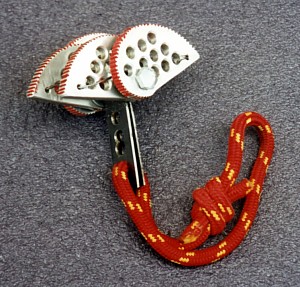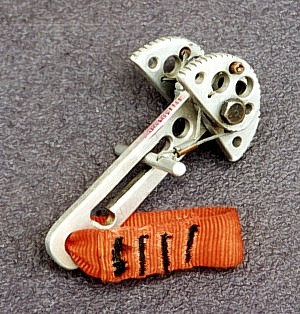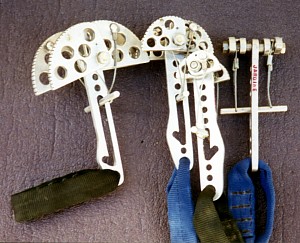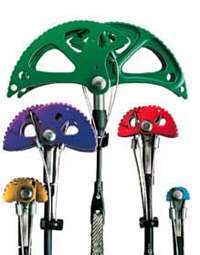| Because the original patents have expired, it's now an open market and we're seeing a plethora of camming devices flooding the market (some good, some not so good...). |
 |
|
The first Friend - 1973 |
A Brief Exposition
by Ray Jardine
Some day we climbers may wear special gloves and shoes enabling us to scale blank walls like spiders. Should we fall off, like spiders our body harnesses may instantly attach safety lines to the rock. If and when inventors develop this technology, we will no doubt consider it clever . . . but obvious - thanks to our 20-20 hindsight. But for now, none of us can envision the details.
And so it was with the Friends 25 years ago when I was inventing them. The need was apparent, at least to me, but the actual configuration was elusive to me and everyone else.
Seeking a devise that would anchor itself in a crack, and hold with greater power the harder the pull, I began the inventive process in 1971 with a dual sliding wedge design. Taking advantage of my aerospace engineering background I analysed this configuration and found it mathematically unsound. The internal friction between any kind of wedges reduce their holding power, and in many situations such a device could pull out. I was inventing for my own use, and was not about to compromise safety.
The summer of 1973 Mike Lowe tried to sell me a few of his new Cam Nuts, which he said his brother Greg had invented. They worked, he explained, on the principle of the constant angle cam. Intuitively I saw that the concept was viable, and felt that here might be the idea I had been looking for. I bought three of them. Unfortunately the first time I used them all three flipped out and went sliding down the rope into my belayer's arms, leaving me running out a 5.9 fist crack unprotected. That was also the last time I used them.
The constant angle spiral is ubiquitous in Nature, from seashells and pinecones to swirling barometric pressure gradients and the great spiral nebulas. Really, it is just an expression of uniform growth. Descartes described the principle mathematically in 1638, calling it the equiangular spiral. Since then, constant angle cams have been used in uncountable mechanical devices. I don't know where Greg got his idea of applying the concept to a crack anchoring device. Perhaps it was from the Jumar ascender, which uses a more-or-less constant angle cam to clinch the rope. At any rate we have Greg to thank for introducing the concept to crack anchoring technology.
Configuring a workable device, however, proved to be an enormous task. In retrospect it took someone with aerospace engineering skills, a questing mind coupled with extreme motivation and a passion for climbing - something of a rare combination perhaps. For months I worked in Bill Forrest's machine shop building camming prototypes, testing them at the local crags and innovating design improvements in the evenings at home. In the end I filled a couple of sizable boxes with discarded prototypes.
Many of these designs were later backwards engineered on the basis of Friends by other companies, and are in production today. This despite the fact that I found them wanting from the beginning, and discarded them. For after all, I did not have to compete with myself, and therefore I had the luxury of moving beyond inferior designs.
Then one day after trying absolutely everything I could think of, and continually straining my mind for ever more ideas, the Creator enlightened me with the concept of a double set of opposing and independently spring loaded cams. Like wheels of a car having independent suspension, each of these cams would be able to adjust to widely varying surface irregularities, within limits of course. I put one of these "quads" together and took it to the crags for testing. The cams were spring loaded against each-other, and they were held together with a high-tensile steel bolt. But the bolt was wrapped with a piece of ordinary strap iron as a stem, and of course the device lacked any kind of trigger. On a 5.8 route which I called Fantasia, located at Split Rocks, I climbed to a stance where I could almost let go with both hands, and managed to squiggle the Quad into a hand-sized crack. By the way it behaved I knew instantly that it was the solution to the problem I had been working on all that time.
 The following spring, 1974, I took my first set of
working prototype Friends to Yosemite and climbed dozens of
difficult routes with them. These units were rough hewn and
extremely limited by today's standards, and I had only a few 2-1/2s
and 3-1/2's. But they certainly proved their worth, and at season's
end three of us used them in an attempt to climb the Nose in a day.
Three hours of downpour late that afternoon immobilized us beneath
the Great Roof and forced a bivvy at Camp V. But we did finish in 20
hours total climbing time, and managed to cut the previous three-day
record in half. The following spring, 1974, I took my first set of
working prototype Friends to Yosemite and climbed dozens of
difficult routes with them. These units were rough hewn and
extremely limited by today's standards, and I had only a few 2-1/2s
and 3-1/2's. But they certainly proved their worth, and at season's
end three of us used them in an attempt to climb the Nose in a day.
Three hours of downpour late that afternoon immobilized us beneath
the Great Roof and forced a bivvy at Camp V. But we did finish in 20
hours total climbing time, and managed to cut the previous three-day
record in half. |
 For the next six years I
continued making improved prototypes. My focus was not in their
commercial application, but on the literally thousands of routes I
used them on, mostly in Yosemite. My partners were limited in number
and "sworn to secrecy" because I felt a little paranoid about the
idea being ripped off by some manufacturer. Meanwhile, I certainly
did give the Lowe brothers plenty of time to introduce workable
camming devices of their own invention, which they did not. For the next six years I
continued making improved prototypes. My focus was not in their
commercial application, but on the literally thousands of routes I
used them on, mostly in Yosemite. My partners were limited in number
and "sworn to secrecy" because I felt a little paranoid about the
idea being ripped off by some manufacturer. Meanwhile, I certainly
did give the Lowe brothers plenty of time to introduce workable
camming devices of their own invention, which they did not. |
In 1977 Mark Vallance invited me to the UK to help him start manufacturing Friends. Mark is a highly dedicated and gifted individual, and was the first person to foresee the widespread appeal of Friends. Friend marketability is obvious now, but it certainly was not then, and Mark was the visionary who made it happen. The next year Mark founded Wild Country and started selling Friends.
What do I think of today's preponderance of Friend look-alikes and so-called improvements?
First, I feel that a certain amount of it is inferior. In the same way that people would not go to quacks for brain surgery, climbers would be unwise to entrust their lives to cheap Friend imitations made of inferior materials. If you have something like this on your rack, you might consider getting rid of it.
Secondly, there are all sorts of gizmos out there which, in my mind at least, are theoretically unsound. Three cam units are one example. Analogously, three wheeled vehicles were banned from the marketplace years ago because of their inherent instability. Many other available gizmos are mathematically unsafe, and I certainly would not entrust my life to them!
Thirdly, there are a number of so-called improvements which in reality are nothing but patent work-arounds. I suspect that they will fade from vogue over time - meanwhile we might be aware of the hype. And lastly, now that the Friend patents are expiring we are seeing virtual-copies by major manufacturers. I believe in higher laws, which is the main reason I recommend only the genuine articles - Friends. These are made by Wild Country.
Ray Jardine
Endnote: (from Wildcountry website in UK)
Today's Forged Friends are the culmination of nearly 30 years of refinements on the original world beating units that emerged from Ray Jardine's workshop in the early '70s.
Since that time they have evolved from the original unit which
revolutionised the climbing world, into a staple for modern climbers
everywhere and are the workhorse of Wild Country's Spring Loaded Camming
Devices (SLCD) range.
Although Ray would recognise these shiny modern units as an inheritor of all
the key features of the original he launched with Wild Country in 1978, they
have certainly been brought up to date with the latest technology.
Along with the Original 13.75 degree camming angle, floating trigger and predictable loading of the 70's unit, modern Friends have a host of new features.

Modern 'Technical Friends'
Note: Main article adapted from Ray Jardine's website